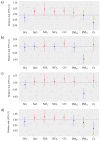Air Pollution Increases Risk of Occurrence of Intracerebral Haemorrhage but Not of Subarachnoid Haemorrhage: Time-Series Cross-Sectional Study
- PMID: 39062135
- PMCID: PMC11274972
- DOI: 10.3390/biomedicines12071562
Air Pollution Increases Risk of Occurrence of Intracerebral Haemorrhage but Not of Subarachnoid Haemorrhage: Time-Series Cross-Sectional Study
Abstract
(1) Background: Haemorrhagic strokes (HS), including intracerebral (ICH) and subarachnoid haemorrhages (SAH), account for approximately 10-15% of strokes worldwide but are associated with worse functional outcomes and higher rates of mortality, and financial burden than ischemic stroke. There is evidence that confirmed poor air quality may increase the incidence of haemorrhagic strokes. The aim of our study was to evaluate the association between individual ambient air pollutants and the risk of haemorrhagic stroke in an urban environment without high levels of air pollution. (2) Methods: A time-series cross-sectional study design was used. A daily air pollution concentration (Agency of Regional Air Quality Monitoring in the Gdansk Metropolitan Area) and incidence of haemorrhagic strokes (National Health Fund) were obtained and covered the time period from 1 January 2014 to 31 December 2018. A generalised additive model with Poisson regression was used to estimate the associations between 24-h mean concentrations of SO2, NO, NO2, NOx, CO, PM10, PM2.5, and O3 and a daily number of haemorrhagic strokes. (3) Results: The single-day lag model results showed that NO2, NO and NOx exposure was associated with increased risk of ICH (88% events) with RR of 1.059 (95% CI: 1.015-1.105 for lag0), 1.033 (95% CI: 1.007-1.060 for lag0) and 1.031 (95% CI: 1.005-1.056 for lag0), but not for SAH (12% events). Exposure to CO was related to a substantial and statistically significant increase in incidence for 1.031 (95% CI: 1.002-1.061 for lag0) but not for SAH. Higher SO2, PM10, PM2.5, and O3 exposures were not significantly related to both ISC and SAH. (4) Conclusions: In this time-series cross-sectional study, we found strong evidence that supports the hypothesis that transient elevations in ambient NO2, NO and CO are associated with a higher relative risk of intracerebral but not subarachnoid haemorrhage.
Keywords: air pollution; gaseous pollutants; haemorrhagic stroke; intracerebral stroke; particulate matter; subarachnoid stroke.
Conflict of interest statement
The authors declare no conflict of interest.
Figures




Similar articles
-
Effects of short-term exposure to air pollution on hospital admissions of young children for acute lower respiratory infections in Ho Chi Minh City, Vietnam.Res Rep Health Eff Inst. 2012 Jun;(169):5-72; discussion 73-83. Res Rep Health Eff Inst. 2012. PMID: 22849236
-
Assessment of Low-Level Air Pollution and Cardiovascular Incidence in Gdansk, Poland: Time-Series Cross-Sectional Analysis.J Clin Med. 2023 Mar 13;12(6):2206. doi: 10.3390/jcm12062206. J Clin Med. 2023. PMID: 36983207 Free PMC article.
-
Mortality and Morbidity Effects of Long-Term Exposure to Low-Level PM2.5, BC, NO2, and O3: An Analysis of European Cohorts in the ELAPSE Project.Res Rep Health Eff Inst. 2021 Sep;2021(208):1-127. Res Rep Health Eff Inst. 2021. PMID: 36106702 Free PMC article.
-
Association between exposure to ambient air pollution and hospital admission, incidence, and mortality of stroke: an updated systematic review and meta-analysis of more than 23 million participants.Environ Health Prev Med. 2021 Jan 26;26(1):15. doi: 10.1186/s12199-021-00937-1. Environ Health Prev Med. 2021. PMID: 33499804 Free PMC article.
-
Short-term exposure to particulate matter (PM10 and PM2.5), nitrogen dioxide (NO2), and ozone (O3) and all-cause and cause-specific mortality: Systematic review and meta-analysis.Environ Int. 2020 Sep;142:105876. doi: 10.1016/j.envint.2020.105876. Epub 2020 Jun 23. Environ Int. 2020. PMID: 32590284
Cited by
-
Ambient versus household PM2.5 exposure and socioeconomic disparities in intracerebral hemorrhage burden: a 32-year global analysis (1990-2021) with projections to 2050.Front Public Health. 2025 Jun 18;13:1615934. doi: 10.3389/fpubh.2025.1615934. eCollection 2025. Front Public Health. 2025. PMID: 40606082 Free PMC article.
References
-
- van Asch C.J., Luitse M.J., Rinkel G.J., van der Tweel I., Algra A., Klijn C.J. Incidence, Case Fatality, and Functional Outcome of Intracerebral Haemorrhage over Time, according to Age, Sex, and Ethnic Origin: A Systematic Review and Meta-Analysis. Lancet Neurol. 2010;9:167–176. doi: 10.1016/S1474-4422(09)70340-0. - DOI - PubMed
-
- Feigin V.L., Krishnamurthi R.V., Parmar P., Norrving B., Mensah G.A., Bennett D.A., Barker-Collo S., Moran A.E., Sacco R.L., Truelsen T., et al. Update on the Global Burden of Ischemic and Hemorrhagic Stroke in 1990–2013: The GBD 2013 Study. Neuroepidemiology. 2015;45:161–176. doi: 10.1159/000441085. - DOI - PMC - PubMed
-
- Butland B.K., Atkinson R.W., Crichton S., Barratt B., Beevers S., Spiridou A., Hoang U., Kelly F.J., Wolfe C.D. Air Pollution and the Incidence of Ischaemic and Haemorrhagic Stroke in the South London Stroke Register: A Case–Cross-over Analysis. J. Epidemiol. Community Health. 2017;71:707–712. doi: 10.1136/jech-2016-208025. - DOI - PMC - PubMed
LinkOut - more resources
Full Text Sources

